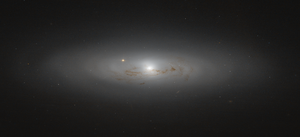NGC 4036
| Galaxy NGC 4036 |
|
|---|---|

|
|
| Photo from the Hubble Space Telescope | |
| AladinLite | |
| Constellation | Big Bear |
|
Position equinox : J2000.0 , epoch : J2000.0 |
|
| Right ascension | 12 h 01 m 26.753 s |
| declination | + 61 ° 53 ′ 44.81 ″ |
| Appearance | |
| Morphological type | S0 / LINER |
| Brightness (visual) | 10.5 mag |
| Brightness (B-band) | 11.5 likes |
| Angular expansion | 4.3 ′ × 1.7 ′ |
| Position angle | 85 ° |
| Surface brightness | 12.7 mag / arcmin² |
| Physical data | |
| Affiliation | NGC 4036 group LGG 266 |
| Redshift | 0.004620 ± 0.000017 |
| Radial velocity | 1385 ± 5 km / s |
|
Stroke distance v rad / H 0 |
(67 ± 5) · 10 6 ly (20.4 ± 1.4) Mpc |
| history | |
| discovery | William Herschel |
| Discovery date | March 19, 1790 |
| Catalog names | |
| NGC 4036 • UGC 7005 • PGC 37930 • CGCG 292-59 • MCG 10-17-125 • IRAS 11588 + 6210 • 2MASX J12012689 + 6153445 • GC 2668 • H I 253 • h 1050 • GALEX ASC J120126.74 + 615346.0 • NVSS J120126 + 615344 • WISEA J120126.77 + 615344.8 | |
NGC 4036 is an elliptical galaxy of the Hubble type E / S0 with an active galaxy core in the constellation Greater Bear in the northern sky . It is estimated to be 67 million light years from the Milky Way and about 85,000 light years across. The galaxy is the brightest member of the NGC 4036 group ( LGG 266 ).
On July 23, 2007, Type Ia supernova SN 2007gi was discovered near the central bulge of this galaxy.
The object was discovered on March 19, 1790 by the astronomer William Herschel with an 18.7-inch telescope .
NGC 4036 group ( LGG 266 )
| Galaxy | Alternative name | Distance / million Lj |
|---|---|---|
| NGC 4036 | PGC 37930 | 67 |
| NGC 4041 | PGC 37999 | 60 |
| IC 758 | PGC 38173 | 62 |
| PGC 37951 | UGC 7009 | 54 |
| PGC 38014 | UGC 7019 | 72 |
